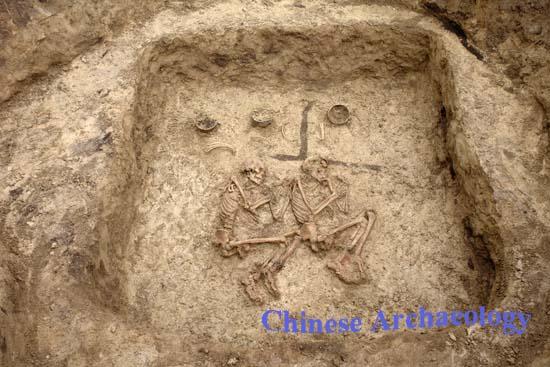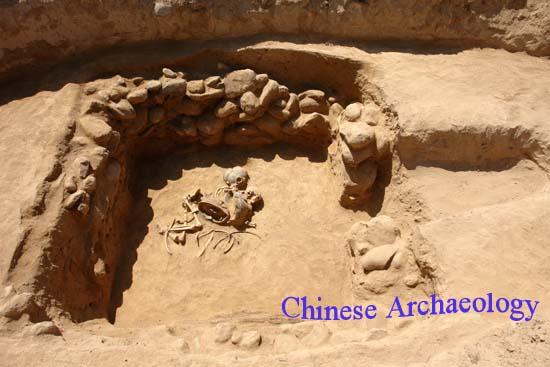Discovery of Andronovo Culture Tombs in the Yili Area of Xinjiang Province
Chinese Institute of Archaeology
Source - http://www.kaogu.cn/en/detail.asp?ProductID=3388
In order to fit the needs of basic constructions, Xinjiang provincial institute of Archaeology and cultural relic conducted a series of excavations in Tangbalisay cemetery in Nilka county, and No.2 cemetery at the west Koksu river in Tekes county in 2011. Totally fourteen tombs dating to the early Bronze Age, the Andronovo culture, were found, with noticeable typical local ceramics providing the significant value for the study.
Tangbalisay cemetery is situated at pastoral area, east to the Kartopa town Karwoy village, Tekes county. The tombs were found at upstream of Kashgar River by the southern bank on the secondary terrace, 1811.5 meter above sea leave. Andronovo tombs were concentrated in the eastern part of the cemetery, where seven tombs were excavated. Due to the higher elevation and ample rainfall, earth mound was covered by grass with 0.1~ 0.2 meters deep. The yellowish earth round mounds is 8 meter in diameter, approximately.

Tomb M17 from Tangbalisay cemetery
The shape of the tomb is shaft earth pit, oriented to the west. The tomb chamber is similar to square in shape, with 1.5~2.5 meter long and 0.6~1 meter deep, and had slightly longer sides to the east and west. Some tombs have one or two skeletons, and some have the traces of cremation. The dead laid on one side with body curved, and oriented to the west, facing the north. The burial goods, two or three ceramic vessels, were normally found beside the head (next the pottery were one or two ribs of goat/sheep). Few dead wore bronze earrings, bronze bean bracelets, and beads chain on feet. They also found some traces of reddle scattering on the lower part of the body in tomb M17. Most of the unearthed ceramics were plain, hand-made, and grey sandy ware, and a smaller quantity are red ware. The vessel type is characteristic of slightly flared rim, folded shoulder, deep belly, and ringed-foot or flat bottom. In terms of ceramic type, they have similar character with Andronovo culture, such as urn shaped and pot shaped vessels, as well as other typical items including bell-end shaped bronze earrings and bronze bead chains.

Bruial offerings from Tangbalisay cemetery
No.2 cemetery in the west Koksu river is situated 20 kilometer south to the Tekes county, on the terrace of the Koksu river to the west, with the elevation of 1298.6 meter. There were seven tombs of Andronovo culture clustered in the center of the cemetery.
It is noticeable that how the mortuary mound (7~20 meter in diameter, 0.5~1.2 mater in height) was constituted of. So, we could divide them into two categories: one is earth mound merely, and one is the earth mound covered by a layer of pebbles like stone-stacked tombs in appearance. Two kinds of grave chamber structure have been identified: one consisted of shaft earth pit in direction of east to west, with simple wooden outer-coffin enclosed with crude wood around the bottom. Normally no skeletons have been seen due to the possibility of secondary burial or disturbed. There was a side chamber in the west wall of the chamber, in which had one sacrificed person with laying on one side and curved body, and one ceramic was found beside the head. The other kind of chamber structure is having a shape approximating that of square with each side 2~4 meters long, 0.6 to 1.5 meter deep. A shorter, sloping passage was preserved in the western part of tomb chamber. Four walls of the chamber were paved with pebble up to the entrance of tomb. Wood structure was found within the chamber, where one or two persons were buried, lying on one side with curved body, oriented to the west, facing the north. Surrounded the death were burial offerings, including two to four ceramics and some horse ribs. Most of the pottery was polishing grey sandy ware, with slightly flared rim, folded shoulder, deep belly, and ringed-foot. They were also. The evidences of the burial structure, burial practices and burial offerings with characters of folded shoulders and ringed-foot exhibit clear Andronovo culture characteristics.

Tomb M53 from No.2 cemetery in the west Koksu river
Andronovo Culture is an important Bronze Age culture prevailing in the central Asia, dating to 4000-3300BP. Recently, remains of Andronovo culture have been frequently found in Xinjiang, mainly concentrating in the areas of Yili River, Tacheng area, and Pamir region. Based on the evidence of excavations and surveys, a large quantity of remains of Andronovo culture may exist in the western area of Xinjiang province with a smaller quantity of such kind of remains found in Gansu and Qinghai provinces. Such remains were not often found within tomb. The discovery of two cemetery of Andronovo cultural mentioned here could provide the important information for understanding the development and interaction of early Bronze times in Yili area, even in Xinjiang and central Asia.

Burial offerings from No.2 cemetery in the west Koksu river
The excavations of two cemeteries have exhibited the similar ceramics type with Andronovo culture, including pot-shaped vessels with large-mouth, round-belly and small-bottom, urn-shaped ceramics with straight-wall, round-belly, as well as bell-end shaped bronze earrings. It indicated the clear relationship with Andronovo cultures. All of the burials had shaft earth pits (No.2 cemetery at the west Koksu river in Tekes county had shafted stone-built chambers tomb and wooden outer-coffin tomb). Inhumation and cremation burial co-existed, and all the dead laid on one side with curved body, orienting towards the west or southwest. The burial structure, burial custom and practice also show close relationships with Andronovo culture. Compared with remains of Andronovo culture, they not only share the same characteristics, but also have its own local features. For example, complicated geometric patterns decorating the entire pottery were often found in overseas Andronovo culture, but few are seen in Xinjiang. The excavations of cemeteries in Nilka and Tekes counties have provided the features of folded shoulder ceramics, flat bottom and ringed-foot ware co-exist, which have never been found before in Xinjiang. Flat bottom pots are similar to those found in the cemetery of Xiabandi in the Tashkurgha. Qihe areas in the central Asia are also characterized of such flat-bottom ceramics, differing from the typical ones of Andronovo culture. Meanwhile their burial structures are also different. Stone chamber with shorter passage did appear in Tekes county, but never found in the Andronovo cultures. The two excavated cemetery mentioned above are located in the same region, the Yili river area, which have the similar cultural characters, but still differ in tomb mound and burial structure. These show the local diversity and evolution. Therefore, we could think that these remains should have been the local type of Andronovo culture distributed in the Yili River area, so-called Tangbalisay type of Andronovo culture. This culture has been identified to be late Andronovo culture dating to 3300BP. (Translator: Sang Li)